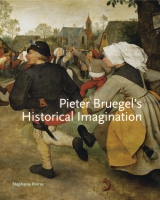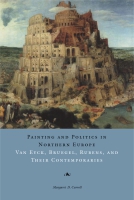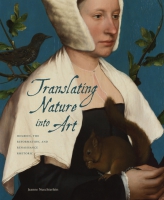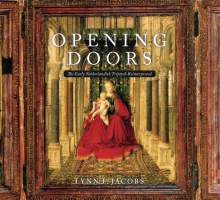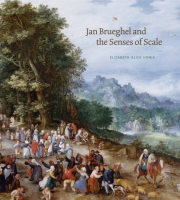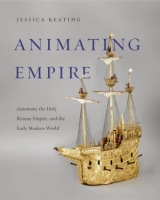Pieter Bruegel’s Historical Imagination
Stephanie Porras
“Porras (Tulane Univ.) elucidates the complex relationship between Bruegel’s paintings and their various contexts, including the intellectual past and the creation of a Netherlandish historical identity. . . . This book is well worth reading for its nuanced interpretation of one of the most popular and beloved painters of the northern Renaissance.”
- Description
- Reviews
- Bio
- Table of Contents
- Sample Chapters
- Subjects
Rather than viewing Bruegel’s art as simply illustrating the social realities of his day, Porras asserts that Bruegel was an artist deeply concerned with the past. In playing with the boundaries of the familiar and the foreign, history and the present, Bruegel’s images engaged with the fraught question of Netherlandish history in the years just prior to the Dutch Revolt, when imperial, religious, and national identities were increasingly drawn into tension. His pictorial style and his manipulation of traditional iconographies reveal the complex relations, unique to this moment, among classical antiquity, local history, and art history.
An important reassessment of Renaissance attitudes toward history and of Renaissance humanism in the Low Countries, this volume traces the emergence of archaeological and anthropological practices in historical thinking, their intersections with artistic production, and the developing concept of local art history.
“Porras (Tulane Univ.) elucidates the complex relationship between Bruegel’s paintings and their various contexts, including the intellectual past and the creation of a Netherlandish historical identity. . . . This book is well worth reading for its nuanced interpretation of one of the most popular and beloved painters of the northern Renaissance.”
“By raising and rephrasing so many questions of central concern not only to our understanding of Bruegel but also to early modern Antwerp in general, Pieter Bruegel’s Historical Imagination expands the discourse in new directions. As we continue with nervous laughter to venture into the worlds of Bruegel’s peasants, and struggle like Ortelius to understand them, Porras’s book will surely remain an engaging source for future study.”
“A thoughtful, intelligent, and learned book. Stephanie Porras culminates many (lesser but) related studies on Pieter Bruegel with new material and a defining argument and provides the most current assessment of the painter’s peasant subjects. For art historians it will serve as a rich mine of cultural history, literary history, intellectual history, and even music history about Flemish culture on the eve of the Dutch Revolt.”
“A smart, important book. . . . Porras has illuminated an aspect of Bruegel’s art that has always been present, though we did not recognize it.”
“Bruegel is often cast as an artist who collects his subject matter, be it children’s games, exempla of virtues and vices, Netherlandish and Latin proverbs, or peasants celebrating during the local kermis. Porras offers us a new facet of this artistic personality, one that has more agency than our previous portraits of the artist.”
“By situating Bruegel’s work within his culture’s search for a Flemish ‘vernacular antiquity,’ Stephanie Porras gives us a new sense of how history could be visually conceptualized, manipulated, and deployed in the mid-sixteenth century and invites us to see familiar aspects of Bruegel’s work as operating in an important context that has never been fully explored before. An engaging and important book.”
“Stephanie Porras’s Pieter Bruegel's Historical Imagination offers a fresh approach to Bruegel's peasant imagery. Smartly escaping the parameters of tired debates as to whether they offer moralizing comments of peasant excess or a lyrical vision of peasant culture for a town-dwelling elite, she argues that they constitute a form of ‘history.’ In an age that saw the revival of ancient arts and letters together with a rising sense of religious and political identity, Bruegel and his contemporaries found, in the life of the peasant, a means of suggesting the unity of past and present.”
“In shifting focus from Pieter Bruegel as a painter of everyday life to the historical imagination which informed his peasant paintings, Porras offers a new and fresh approach to this canonical artist. Porras’s own historical imagination is impressive, based on meticulous and wide-ranging scholarship in both visual and textual materials. This book is an important contribution to the field.”
Stephanie Porras is Assistant Professor of the History of Art at Tulane University.
Contents
List of Illustrations
Acknowledgments
Introduction:
Peasants and Pagans
The Archaeological Peasant
Hybrid Histories
Bacchic Excess
Bruegel’s Art History
Conclusion:
Bruegel as History
Notes
Bibliography
Index
The English word pagan describes either a follower of no religion or an indi- vidual of polytheistic faith. The word itself has an intriguing etymology. Like the French païn, it is derived from the Latin paganus, or peasant. The religious sig- nificance of paganus, preserved in the modern English and French derivations, is believed to have arisen from the conservative rural adherence to the old gods after the Christianization of Roman towns and cities. Paganus thus came to distinguish believers and heathens, urban and rural, military and civilian popu- lations.1 One of the first early modern multilingual dictionaries, Christopher Plantin’s 1562 Latin-Greek-French-Dutch Dictionarium Tetraglotton, draws on these implicit distinctions in its translation of paganus as the French villageois and paysant, as well as the Dutch dorpman or boer.2 Thus translated, paganus is the word for rustic, farmer, or peasant.
But Plantin’s dictionary also alludes to the modern usage of the word pa- gan. The entry preceding paganus in the dictionary is paganalia, a word that in the sixteenth century was freighted with religious significance and particularly associated with pre-Christian worship. Paganalia is translated as fêtes de villag- es, boeren feeste, and dorpfeesten (village or peasant festival). The contemporary
peasant festival is thus laden with a frisson of the idolatrous past. Plantin’s defini- tion of paganus collapses the temporal distinction between classical antiquity and the vernacular present. The country farmer at the fringes of the Roman Empire be- comes the sixteenth-century Dutch peasant, similarly removed from an early modern Netherlandish culture renowned for its cities. In both cases, the paganus is symboli- cally left behind in a changing world.
But what facilitated Plantin’s translation of the antique heathen into the form of the local peasant? Moving between paganus and peasant (boer) is a linguistic and social as well as a temporal shift. Historical imagination—the reconstruction of the past but also the active creation of tradition—underpins such a translation. Coined by the English philosopher Owen Barfield, historical imagination describes the pro- cesses by which the past is re-created in the mind of the historian.3 This book inves- tigates how the early modern historical imagination enabled the sixteenth-century Netherlandish peasant to become an embodiment of pagan antiquity. Focusing on the works of one of the period’s great artists, Pieter Bruegel the Elder, I explore the fluid and flexible approach to the picturing of local history in Bruegel’s age.
Today, Bruegel is rarely recognized as an artist concerned with history or the historical imagination. Instead, he is best known as a Renaissance artist of the every- day world, the painter of Dutch proverbs (Netherlandish Proverbs, fig. 1), of Children’s Games (fig. 3) and of the contemporary Netherlandish peasant at work and at play, as in the iconic Hunters in the Snow (fig. 2). Although Bruegel designed numerous religious images, landscapes, and scenes evocative of his predecessor Hieronymus Bosch (fig. 4), Bruegel’s current art-historical identity is equated predominately with his peasant pictures. The word paganus, then, accurately describes the subjects of Bruegel’s most enduring and debated images.
In this volume I argue that Bruegel’s famous peasant pictures and Boschian nightmares, his scenes of biblical history, landscapes, and proverbs, and his skillful manipulation of various painting styles uniquely represent the multifaceted concept of history as understood in the sixteenth-century Low Countries. This shifting notion of history is evoked in the definition of paganus offered by Plantin’s dictionary, and I situate Bruegel’s work within a diverse network of artists, publishers, historians, ge- ographers, politically motivated nobles, and socially ambitious merchants, who were all involved in the early modern imagining of Netherlandish history.
This book seeks to reclaim Bruegel as an artist of the sixteenth-century histori- cal imagination, embodying the Janus-faced character of Renaissance Europe: ob- sessed simultaneously with the past and with an uncertain future. Though centered on Bruegel, this book proposes a broader reassessment of Renaissance attitudes toward history and traces the emergence of archeological and anthropological prac- tices in historical thinking, as well as their intersections with artistic production. The mining of classical texts, the foundation of archaeology, the study of custom, and an emerging conception of local art history were all part of reconstructing the past in the Low Countries. This book therefore is aimed not only at art historians interested in Bruegel but also at early modern historians, scholars of literature and historiography interested in the formation of Netherlandish historical identity in the sixteenth cen- tury and in competing Renaissance notions of history more generally.
I began with the definition of paganus because I believe that it points to an un- tapped understanding of Bruegel’s work and of early modern historical thinking. The space between the paganus and the boer, Latin and Dutch, classical antiquity and the everyday world of the sixteenth-century Low Countries, is exactly where art historians have grappled with Bruegel’s works. How do we reconcile Bruegel’s famous peas- ant subjects with the great humanist and geographer Abraham Ortelius’s praise of Bruegel as being like the ancient Greek painter Apelles? Paganus naturalizes this surprising comparison by articulating the tension between past and present, local and universal, that many scholars of Renaissance culture see as emblematic of early modern thought.
Traditionally, art-historical writing on Bruegel attempts to fit the artist into one of two dominant narratives: Bruegel is either a social satirist, presenting images of the peasantry in service of a traditional cautionary moral, or Bruegel is a proto-ethnog- rapher, recording peasant culture for a newly emergent urban audience that enjoyed visiting rural festivals. More recently, scholars have sought the middle ground, stress- ing Bruegel’s role as both traditionalist and innovator.4 In light of this recent work, I argue that Bruegel navigated a shifting terrain in aligning classical antiquity and vernacular tradition, forging a unique vision of the Netherlandish past while also recording the anxieties of the contemporary moment. In his famous peasant scenes, his images of biblical and classical narratives, and his innovative deployment of vari- ous stylistic modes, Bruegel confronted history — the pagan past, local custom, and the artist’s own representational heritage. In doing so, Bruegel presented an image of how the sixteenth-century Low Countries saw their own antiquity and modern re- birth, their own “Renaissance.”
Defining Antiquity
Before discussing Bruegel’s interest in history, it is first necessary to recognize what antiquity meant in the Low Countries of the 1550s and ‘60s. Sixteenth-century Europeans were obsessed with the search for origins. Renaissance humanism is usu- ally associated with the revival of classical learning, the translation of ancient texts and civic forms, and an attempt to place the civilizations of Greece and Rome at the foundations of European culture. In the popular imagination, the Renaissance is par- ticularly identified with Italy and with the revival of classical style in art and literature.
But classicism was not the only aesthetic language used to evoke the antique past. The Renaissance interest in antiquity was everywhere experienced as a local phenom- enon, and each locality had its own particular genealogies to explore, in conjunction or in competition with ancient Greece and Rome. Elizabeth Honig has called these local Renaissances multilingual, capable of using multiple styles and historical refer- ents concurrently, all in the service of the revival of “antiquity.”5
The import of classical ideas thus coincided with the search for a vernacular, that is, indigenous, identity. In northern Europe there were fewer standing monuments of classical antiquity than in Italy and southern Europe; thus the region had a less mani- fest claim to directly resurrect the Greek or Roman past of their ancestors. Local history therefore became a crucial supplement to northern notions of antiquity and cultural identity. Recognizing this hybrid nature of northern humanism nearly fifty years ago, Jean Seznec, in his seminal work The Survival of the Pagan Gods, wrote that in the North the cultural reintegration of the pagan gods was supplemented by “something of their own blood and soil.”6 Seznec recognized the hybrid alterity of the Renaissance outside Italy, where antiquity was understood as intimately connected to local tradition.
Acknowledging the diversity of Renaissance “antiquities,” I use the term antiquity to refer to both classical (Greek and Roman) cultures of the pagan past and those distinct- ly Netherlandish historical traditions and customs seen by Bruegel’s contemporaries as comparably ancient. In contrast to my use of the term antiquity, which can be under- stood as both local and foreign, I use the word classical specifically to demarcate subject matter drawn from the ancient cultures of Greece and Rome, as opposed to local or vernacular conceptions of antiquity. With these terms I seek to replicate the multiple ways in which Bruegel and his contemporaries imagined their own history.
By the mid-sixteenth century, the search for local cultural origins was well under way in the Low Countries, not in competition with classical scholarship but as its complement. Antiquarians and geographers like Abraham Ortelius were interested in the history and culture of Greece and Rome, as well as in local Netherlandish his- tory, geography, and customs.7 In 1552, Ortelius published his first map, an illustra- tion of Brittenburg (fig. 6), the ruins of a Roman fort off the coast of Katwijk, near Leiden. The fort was believed to mark the bounds of the classical Roman Empire, but, crucially, these ruins were not seen as the vestiges of a conquering antique civiliza- tion. Instead, material found at the site fed the contemporary belief that the historical people of the Low Countries had been trading partners, even allies, of the Romans. These antique Netherlanders, the Batavians, were mentioned in Tacitus’s first-century Germania and had been the subject of historical writing and mythologizing since the start of the sixteenth century.8
As I argue in subsequent chapters, Brittenburg was a symbolic locus at the inter- section of local and classical history in the Low Countries. The rise of archaeological interest in sites like this, increasing etymological and philological research into the origins of Netherlandish place-names, and the publication of works on Dutch lan- guage and customs were all part of a search for local origins and an emerging sense of Netherlandish cultural history. Given the limited textual references to the Batavians in surviving classical sources and the local scarcity of antique archaeological survivals, it was necessary for Netherlandish historians to look elsewhere for an account of their past. Peasant culture and local tradition were mined for their historical value, as living remnants of the past. Costume, vernacular architecture, and peasant custom were all increasingly described as historic. The Netherlandish search for origins thus encom- passed classical antiquity, local history, and the articulation of a vernacular identity.
Bruegel’s art both reflected and contributed to the creation of this hybrid past, or what I call here a vernacular antiquity. Bruegel not only depicted many of the customs of particular interest to historians and collectors of customs; he shared these authors’ and publishers’ concern with reproducing the material detail of these local traditions. He also deployed various artistic styles, returning again and again to techniques and iconographies historically valued in the Low Countries. On at least one occasion, in the drawing The Calumny of Apelles (fig. 60), Bruegel also directly confronted the ar- tistic masters of classical antiquity. I argue in this book that Bruegel’s pictures, in what they depict and how they do so, exhibit a complex relationship to time and social context embedded in the creation of a Netherlandish historical identity.
Mailing List
Subscribe to our mailing list and be notified about new titles, journals and catalogs.
